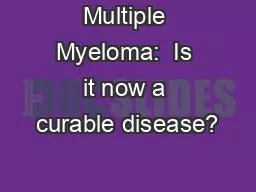

Pritesh Patel MD OVErview Disease overview How I approach initial treatment Treatment considerations at relapse 96000 MM patients How many people are affected by myeloma National Cancer Institute Survival Epidemiology and End Results Program SEER Cancer Statistics Review 19752012 Ava ID: 784647
Download The PPT/PDF document "Multiple Myeloma: Is it now a curable d..." is the property of its rightful owner. Permission is granted to download and print the materials on this web site for personal, non-commercial use only, and to display it on your personal computer provided you do not modify the materials and that you retain all copyright notices contained in the materials. By downloading content from our website, you accept the terms of this agreement.
Slide1
Multiple Myeloma: Is it now a curable disease?
Pritesh Patel, MD
Slide2OVErview
Disease overview
How I approach initial treatment
Treatment considerations at relapse
Slide3≈96,000
MM patients
How many people are affected by myeloma?
National Cancer Institute Survival Epidemiology and End Results Program SEER Cancer Statistics Review 1975-2012. Available at
seer.cancer.gov
accessed 4/30/16
Slide4≈30,000
new diagnoses
How many people are affected by myeloma?
National Cancer Institute Survival Epidemiology and End Results Program SEER Cancer Statistics Review 1975-2012. Available at
seer.cancer.gov
accessed 4/30/16
Slide5Myeloma cells
Bone related signs and symptoms
Impaired immune system
Grow in bone marrow
M Protein
Anemia
10-35%
Lytic
Lesions
70%
Bone
Pain
50%
High blood calcium
15-20%
Infection
15%
Neuropathy
5%
Kidney
failure
25-30%
Slide6Slide7What is the “m Protein”?
Light
chain
Heavy
chain
Protein normally made by plasma cells
Single type produced by myeloma cells
Can be measured at diagnosis in urine and blood
Level can be tracked for disease response and relapse
Slide8The natural history of myeloma
Active
myeloma
PLATEAU REMISSION
1
ST
RELAPSE
1
st
line
2
ND
RELAPSE
Asymptomatic
Symptomatic
TIME
M-PROTEIN
Late Myeloma
Plasma Cell Leukemia
20
50
100
“Operational” cure
Slide9Questions at diagnosis
Do I have SYMPTOMATIC myeloma?
What is my prognosis/ stage
etc
?
Am I eligible for stem cell transplant?
What initial treatment?
Slide10C
bone marrow plasma cells
>
10% or biopsy proven
plasmacytoma
and one of the following
Hypercalcemia
: >11mg/
dL
or 1mg/
dL
higher than ULN
R
Renal impairment: >2mg/
dL
or clearance <40ml/min
A
Anemia: >2g/
dL
below LLN or < 10g/
dL
B
Bone lesions:
>
1 bone lesion on CT, PET or x ray, osteopenia
S
L
i
M
Sixty percent or greater plasma cells in bone marrow
Light chain ration of >100
MRI lesion
>
5mm
Slide11Baseline testing
Slide125 year survival
National Cancer Institute Survival Epidemiology and End Results Program SEER Cancer Statistics Review 1975-2012. Available at
seer.cancer.gov
accessed 4/30/16
Slide13How is myeloma staged?
I
II
III
STAGE
CRITERIA
β
2
microglobulin
<3.5mg/
dL
Albumin >3.5g/
dL
AND
Normal LDH
AND standard risk karyotype
Neither stage I or II
β
2
microglobulin
>5.5mg/
dL
AND EIITHER
high LDH
OR
high risk karyotype
Slide14Who can undergo stem cell transplant?
Decision based largely on functional class and comorbid illness
Can be performed safely in many patients in 70s
Patient choice
Slide15The principle of autologous transplant
Blood stem cell mobilization
High dose
melphalan
Cell freezing and storage
Stem cell re-infusion
Blood counts decrease then and recover
Slide16Risks and benefits of transplant
Slide17Initial treatment- transplant eligible
Slide18Initial treatment- transplant ineligible
Slide19Considerations in initial treatment
Slide20Commonly used medications
Slide21Principle of “maintenance”
Initial therapy reduces disease
Maintenance is a less intensive phase of therapy
Maintain remission as long as possible without significant compromise of quality of life
Slide22IFM
2009 Phase III Randomized Trial
Attal, et al.
Blood.
2015; 126:
abst
391.
Results (f/u 39 months)
Complete remission 58% in ASCT arm vs. 46% in RVD arm
3-year PFS 61% in ASCT arm vs. 48% in RVD arm
Median OS similar at 3 years (88%)
VS.
N=700 Untreated Patients
Slide23Supportive care
Anti-infection prophylaxis
e
.g. acyclovir with
bortezomib
Anti-thrombotic prophylaxis
Risk factors include medications and immobilityBone healthBisphosphonates and calcium
Slide24Considerations in Relapsed myeloma
When to treat?
Which treatment to use?
Organ dysfunction
S
ide effectsRe-treatment
Slide25Newly Approved agents for relapsed disease
Slide26Summary
Prolonged remissions are achievable in 2016
Goal to achieve deep response
Maintained with less intense therapy
Now a large number of options at relapse